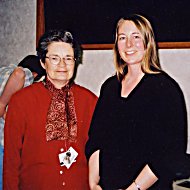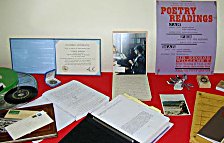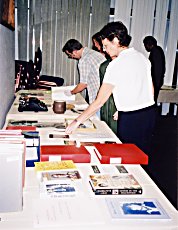 |
  
January / February
2001
Vol. 33, no. 1
|
SAVOIR FAIRE
A Writer’s Life
Susan Globensky, Research and Information Services

From left to right: Linda Hoad and Catherine Hobbs.
|
The new season of SAVOIR FAIRE was launched on September 19, 2000, with an informative seminar on the National Library’s collection of literary manuscripts. Curators Linda Hoad and Catherine Hobbs presented "A Writer’s Life: Literary Manuscripts at the National Library of Canada", which offered a fascinating glimpse into the lives and works of Canadian writers through their collections of manuscripts, papers and ephemera.
Linda Hoad began the well-attended seminar with a brief history of the Collection, which originated with a bequest made by award-winning poet and editor Arthur Stanley Bourinot in 1969. Along with Bernard Amtmann, a prominent antiquarian bookseller and proponent of Canadiana, Bourinot contributed fonds that were to form the core of what would gradually evolve into an important manuscript collection. Guy Sylvestre, the then national librarian, lent his support to the project, and incorporated the Literary Manuscript Collection into his vision of the National Library of Canada.
From its modest beginnings in the early 1970s, the Collection grew in fits and starts, often subject to the fiscal climate of the times. The affluence of the late 1970s and 1980s allowed for a notable increase in acquisitions. The Collection has grown substantially and now includes the fonds of Carol Shields, Phyllis Webb, Michel Tremblay and Roger Lemelin, to mention only a few.

|
Catherine Hobbs continued the presentation with a clear explanation of the Collection’s acquisition criteria. The National Library seeks to acquire the manuscripts, working papers, correspondence, juvenilia, and related materials of Canadian writers in both official languages. In addition, the Library collects the working papers and ephemera of individuals and organizations related to the field of Canadian literature and publishing. With budgetary constraints always an issue, Ms. Hobbs explained how potential acquisitions are carefully researched and assessed against the Collection’s mandate before the National Library enters into negotiation with writers.
Ms. Hobbs noted that the acquisition of manuscripts can at times rely upon a certain amount of good fortune -- the simultaneous availability of both fonds and funds. Citing the example of novelist and poet Elizabeth Smart, Ms. Hobbs recounted how a case of sheer luck, a random phone call, and the assistance of a Canadian Cultural Property Grant ultimately led to the important acquisition of Ms. Smart’s fonds, which includes a unique and highly coveted holograph of By Grand Central Station I Sat Down and Wept.
Ms. Hoad stressed the importance of the Collection in terms of its relevance to Canadian culture, literature and scholarship. The Manuscript Collection offers unique insight into the lives and creative practices of both new and established Canadian writers. Scholars can trace the genesis of a literary work through its many drafts and revisions. Manuscript annotations, for example, often reveal clues to the inspiration and evolution of a writer’s work. One example that Ms. Hoad highlighted was the first page of Carol Shields’s novel Stone Diaries, which notes comments and suggestions made by her two daughters. Other materials in a writer’s fonds mirror the events and priorities during a given period of his or her career. While the ticket stubs, posters and other ephemeral components of a fonds can confound the best efforts of cataloguers, these items nonetheless represent important markers in the lives and careers of those who collected them.

Selections from the Literary Manuscript Collection.
|
In many ways the Collection also emphasizes the solitary vocation of the writer. This isolation, which is an inevitable circumstance of writing, leads many writers to seek interaction, criticism and reassurance through their correspondence with friends and colleagues. Some of Michael Ondaatje’s correspondence solicits the suggestions of friends, which he then used to help shape his work. Correspondence for many writers is an essential part of the artistic process.
The Literary Manuscript Collection is extremely valuable for specialized research. For example, many scholars use the Collection to assist in the compilation of detailed bibliographies. Indeed, scholarly research is an important activity that has reciprocal benefits for the fonds itself: in-depth research often produces a greater degree of descriptive cataloguing of the fonds. The fonds of Marie-Claire Blais were instrumental in the preparation of Irène Oore and Oriel C.L. MacLennan’s Marie-Claire Blais: An Annotated Bibliography (Toronto: ECW Press, 1998).
Other scholarly researchers make use of the Collection when preparing biographical material on a particular writer. Award-winning writer François Ricard consulted the Gabrielle Roy fonds while compiling Gabrielle Roy, une vie: biographie (Montreal: Boréal, 1996); and the Moodie-Strickland-Vickers-Ewing family fonds were essential to Charlotte Gray’s research for her Sisters in the Wilderness: The Lives of Susanna Moodie and Catherine Parr Traill (Toronto: Viking, 1999). Although some restrictions pertaining to privacy may apply to a fonds, biographers often benefit from access to the variety of notes, correspondence and ephemera that are available for consultation.
The presentation ended with a brief question and answer period, after which the audience was invited to browse through a display of artifacts selected from various fonds within the Collection. Literary manuscripts by Gabrielle Roy and Carol Shields, working papers and postcards from the Michael Ondaatje fonds, and some unusual ephemera -- including an intriguing collection of teaspoons "liberated" from several Parisian cafés by members of the Coach House Press -- were the crowning touch to an enlightening and entertaining seminar.
|